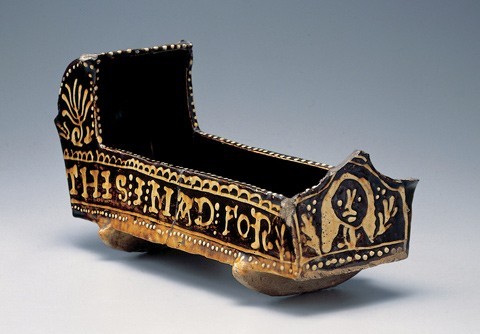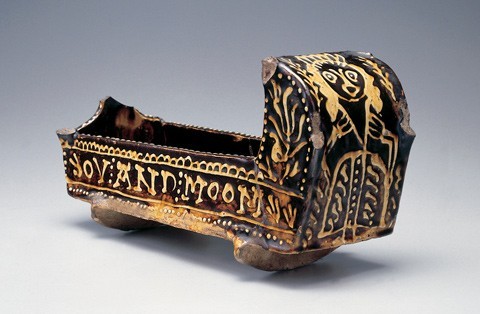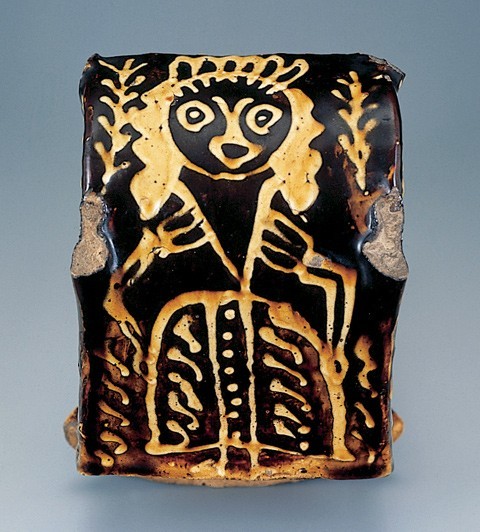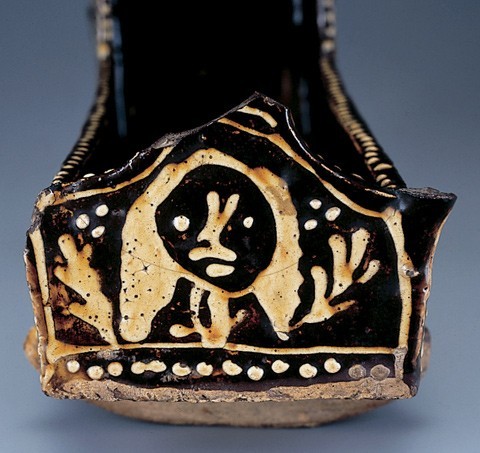
Cradle, Staffordshire, ca. 1710. Slipware. L. 14". The side shown is inscribed with trailed slip “THIS I MAD FOR.” Note how the bonnet curves from front to back. (Photos, Gavin Ashworth.)

Opposite side of the cradle illustrated in fig. 1, inscribed “YOV AND MOOM.”

Detail of the cradle bonnet decorated with the portrait of “MOOM.”

Detail of the foot of the cradle with the portrait of “YOV”
Earthenware decorated with white or colored slip was popular in England throughout the seventeenth and eighteenth centuries. All sorts of vessel shapes were made in slipware: plates, chargers, condiment dishes, porringers, honey pots, mugs, tygs, posset pots, and jugs.
One of the rarer slipware forms is the diminutive cradle, which was made in a variety of sizes from about the 1670s to the early eighteenth century.[1] Through the years, collectors and curators have speculated about their use. They may have served as christening gifts or perhaps as fertility symbols for newlyweds (today we throw rice). Some collectors believe they functioned as convenient containers on chests as “hold alls” for coins, rings, and all the small things otherwise easily lost in a drawer. Larger cradles may have been used to hold children’s dolls.
One such slip-decorated cradle, made in Staffordshire around 1710, displays some unique attributes (figs. 1, 2), the most unusual of which is the shape of its bonnet. The hoods of most slip-decorated cradles curve over the bed from side to side. The bonnet on this example, however, arches from front to back.
The buff-colored body is covered with a brown slip except for the exterior base and runners. A thick white slip was used to draw the portraits of a mother on one end and her child on the other (figs. 3, 4) as well as to inscribe on the sides: “THIS I MAD FOR YOV AND MOOM.” White dots produce the jeweling that decorates the exterior and top edges of the cradle. A colorless lead glaze covers the decorated surfaces.
The inscription reveals that this cradle was probably made by the potter for his family.[2] It may have been a toy; possible evidence of this is its hard life: all six finials are missing, and at some point it was broken in half. Despite its rough condition, it is a favorite in my slip-decorated pottery collection.
Robert Werowinski
James Island Antiques
<JamesIslandAntiq@aol.com>
Leslie B. Grigsby, The Longridge Collection of English Slipware and Delftware, 2 vols. (London: Jonathan Horne Publications, 2000).
Many cradles are decorated with portraits of people wearing crowns. If the woman in this portrait is crowned—and she appears to be—then she would be a royal figure, not the potter’s wife.
